Materiality 1 Contributing to a Sustainable Global Environment
![]()
Basic Ideas and Visions
Corporate management in harmony with the global environment plays an important role in the sustainable development of society and companies. In addition to reducing resource and energy consumption as well as the environmental impact associated with business activities, the Hitachi High-Tech Group aims to achieve sustainable consumption and production through the provision of environmentally-conscious products and services as well as initiatives throughout the value chain.
Action Targets
1. Realize a decarbonized society
To reduce CO2 emissions from energy consumption associated with our business activities, we aim to achieve carbon neutrality at its sites by systematically investing in environmental equipment that has a meaningful impact on reducing CO2 emissions and by actively promoting the use of renewable energy. We will also endeavor to reduce CO2 throughout the value chain, including Scope 3 (CO2 emissions from sites other than our own) emissions and our customers’ contribution to CO2 reduction.
2. Realize a recycling oriented society
Hitachi High-Tech strives to effectively use water, conserve resources, and reduce waste in its business activities. Specifically, we will reduce the amount of water used in factories and use fewer resources in the manufacture of products through the adoption of environmentally conscious design (eco-design) in products. In addition, with the aim of realizing a circular economy, we will work to develop and provide customers with solutions that contribute to resource recycling.
3. Realize a society in harmony with nature
In order to reduce the negative impact of business activities on natural capital, we will work to reduce the negative impact of chemical substance emissions, and aim to realize a rich future for both people and nature. We will work on biodiversity conservation activities such as forest conservation activities that will increase the positive impact.
Action Plan

![]() Analytical & Medical Solutions
Analytical & Medical Solutions
![]() Nano-Technology Solutions
Nano-Technology Solutions
![]() Value Chain Solutions
Value Chain Solutions
![]() Core Technology Solutions
Core Technology Solutions
Content of Initiative
Action Targets 1 Realize a decarbonized society
1 Providing high-performance, low-cost semiconductor manufacturing and testing solutions![]()
FY2022 Results
Contributing to digital society decarbonization through efforts toward low-power, high-throughput semiconductor manufacturing in Japan and overseas
As demand for semiconductors grows, increases in power consumption and CO₂ emissions from semiconductor manufacturing is becoming an issue. As a developer and provider of equipment used in the processing, measurement, and inspection procedures of our customers' semiconductor manufacturing processes, we are working to address these issues from the perspectives of both the equipment we continue to manufacture and sell, and the new equipment we are developing. For existing products, we are working to extend the service life of periodically replaced parts and reduce the number of parts scrapped. Newly developed equipment will pursue high-speed processing and reduce environmental impact, including power consumption per wafer.
- In FY2022, we combined our CG7300 CD Measurement SEM for inspecting and measuring semiconductors, with Materials Informatics*5 (MI), which uses AI to enable speedy inspections previously performed by humans, and this technology was adopted by a semiconductor materials manufacturer. The combination of semiconductor measurements and MI solutions using AI to confirm this data is a proprietary technology of Hitachi High-Tech.
- We also launched the LS9600 wafer surface inspection system offering high sensitivity and high throughput, contributing to improved yields and reduced inspection costs associated with the mass production of semiconductor devices.
- Although the supply chain was disrupted by the pandemic, we were able to ensure delivery of parts needed by the customers who use our equipment by increasing procurement sources, thereby contributing to customer business continuity. We are moving forward to increase the number of parts suppliers in preparation for unforeseen circumstances in the future.
- Among efforts to reduce power consumption and increase throughput, in August 2022, we established a new collaborative base, the Nanotechnology Innovation Center Portland, in the United States. This new base will enhance collaborations with customers in each semiconductor manufacturing process, reducing time required for development and creating solutions that improve production and yield, thereby contributing to future CO₂ emissions reductions and power conservation. From a macro perspective, by contributing to the production of high-performance, low-cost semiconductors, we also contribute to the reduction of CO₂ emissions associated with the advance of digital society.
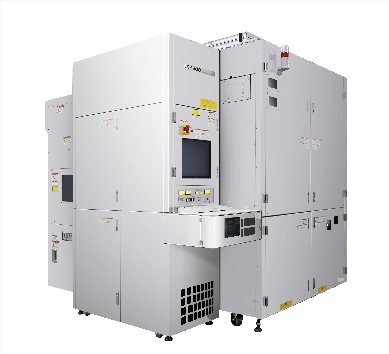
LS9600 wafer surface inspection system
Initiatives for FY2024
In addition to the US, co-creation centers will be established in Taiwan and South Korea. Strengthening relationships with customers to reduce environmental impacts
Following the establishment of a base in the US in 2022, we will establish bases for collaborative creation with customers in Taiwan and South Korea. Up to now, customers were required to bring target wafers to Japan for inspection and measurement.
Establishing local bases will drastically reduce travel time and effort, as well as lower energy consumption and CO₂ emissions. We will create and provide new value by shortening the distance between Hitachi High-Tech and local customers and deepening our relationships with them at these new collaboration bases.
*5 For details, please see Materiality 3 Action Plan 1.
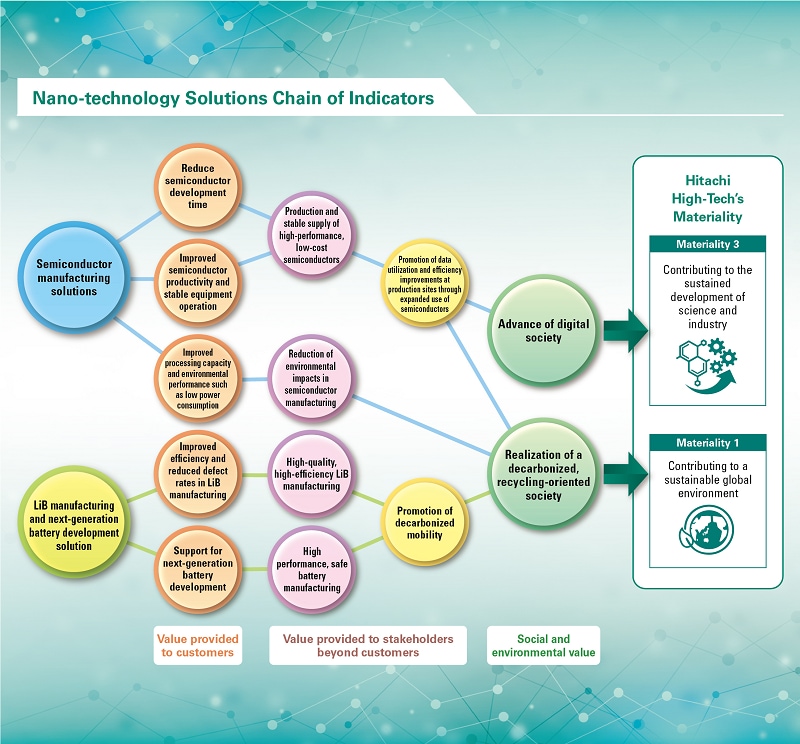
2 Provide measurement and inspection solutions in the R&D of materials to help achieve carbon neutrality![]()
FY2022 Results
Supporting the development of next-generation materials to curb the acceleration of global warming
Amid concerns about the rapid advance of global warming, there is a need for the highly efficient development of next-generation materials in order to achieve carbon neutrality. In particular, the research and development of next-generation batteries, catalyst research aimed at realizing a hydrogen society, and bioplastic development are advancing all over the world to realize carbon neutrality. In the manufacturing of solid-state batteries, the development of which is also advancing within next-generation batteries, stabilizing material quality is an important issue for mass production. Hitachi High-Tech contributes to next-generation battery material quality control through the provision of analysis and testing equipment. Additionally, hydrogen is also attracting attention as a next-generation energy source that emits no CO₂. However, to realize a hydrogen society, we must first start with hydrogen production, and in order to produce and use hydrogen, a catalyst is required. Our analysis and testing equipment is also used in catalyst research. Further, there is an urgent need for the development of biodegradable and biomass plastics as alternatives to microplastics, which have a concerning impact on marine ecosystems. In developing bioplastics, one major challenge is to find materials that are safer and have less environmental impact. In all fields, material development is the vital key to protecting the global environment and mitigating the effects of global warming. Hitachi High-Tech will promote these initiatives in collaboration with companies, universities, and research institutions in various countries by leveraging our core technologies, which include electron microscopes, analytical systems, and analyzers, as well as Observation, Measurement, and Analysis technologies and knowledge.
Initiatives for FY2024
Material development efforts aimed at halting the advance of global warming
Amid a torrent of global issues, including energy shortages, global warming, and the realization of a recycling-oriented society, demands for the development of materials that resolve these challenges are becoming increasingly varied and complex. Although the development of materials targeting these issues is becoming increasingly difficult, we will continue to provide equipment to a wider range of areas, automate data analysis, and improve functionality, thereby contributing to the efficiency and acceleration of materials development aimed at resolving these issues. In developing increasingly complex materials, it is important to accelerate both data analysis as well as how the date is interpreted. Hitachi High-Tech will continue contributing to speeding up the interpretation of data using our proprietary MI solutions*1 utilizing AI-driven materials informatics.
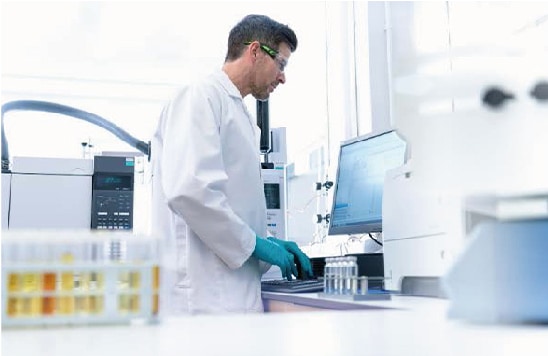
3 Provide solutions that contribute to manufacture of safe and inexpensive LiBs that drive electrification and development of next-generation LiBs![]()
![]()
FY2022 Results
Contributing to the development and manufacture of next-generation batteries
As the shift from gasoline- and diesel-powered vehicles to EVs accelerates, so does the development of next-generation batteries. Hitachi High-Tech continues to provide LiB manufacturing facilities and next-generation battery prototype manufacturing facilities, and dispatches engineers to manufacturers that have newly entered the next-generation battery manufacturing market to provide technical support. In the field, after establishing relationships of trust, we listen to the expectations of manufacturers and propose concepts for manufacturing facilities. In 2022, we provided prototype facilities to some of these manufacturers and have commenced trial operations.
Applications for next-generation batteries are diversifying, and the standards and designs required for next-generation batteries are also undergoing significant changes. In particular, LiBs have been getting larger in recent years, which has led to an increase in materials used and the discovery of numerous safety issues. As defects in large LiBs can result in significant costs and safety losses, reliable defect detection is a necessity for any next-generation battery manufacturer. In 2022, we provided an in-line inspection solution utilizing electron microscopes and X-ray particle analyzers that lowered LiB manufacturing defect rates and facilitates comprehensive inspections. Changing the former random inspection process to a 100% inspection process enables the detection of possible defects in upstream processes. As battery standards and designs undergo major changes, mass production yield rates and other issues are arising. We are currently working with customers to identify defect factors and other issues in the product manufacturing process to prepare for mass production. We are also accelerating collaborations with manufacturers of next-generation batteries, both in Japan and overseas.
Initiatives for FY2024
Strengthening our cooperative structure by increasing the number of engineers dispatched to next-generation battery manufacturers. Aiming to realize a solutions and manufacturing DX that uses data to address contaminant problems
Amid rapidly growing demand for next-generation batteries, there is an urgent need to develop next-generation battery manufacturing facilities that are safe and have a low defect rate, both in Japan and overseas. Going forward, we will increase the number of engineers dispatched, share and quickly resolve issues with customers at next-generation battery manufacturing sites, and contribute to the realization of next-generation battery pilot production in FY2024. For equipment to be safe and have a low defect rate, there is an urgent need to realize solutions and manufacturing DX that uses data to improve contaminant problems identified during inspections. Hitachi High-Tech will focus on the development of equipment and technologies with the aim of popularizing safer EVs and realizing a decarbonized and recycling-oriented society.
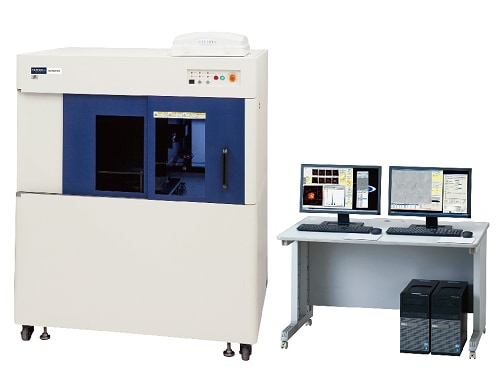
X-ray Particle Contaminant Analyzer EA8000A
4 Initiatives to create energy, introduce renewable energy, and conserve energy with the aim of achieving carbon neutrality in Group global factories and offices
FY2022 Results
Group global CO2 reduction efforts aimed at addressing climate change and realizing a decarbonized society
Electric power accounts for approximately 97% of the energy used in Group business activities. Converting to the use of renewable energy for electric power is an effective way to efficiently reduce CO₂ emissions. With the aim of realizing a state of zero CO₂ emissions by FY2027, we are promoting the transition to renewable energy power as a top priority for the entire Group, including overseas companies. In FY2021, we introduced an internal carbon pricing system (internal carbon price: ¥14,000/t-CO₂), starting with domestic manufacturing site investments made in FY2022. At domestic manufacturing sites, we promoted emission reduction activities based on continuous investments in energy conservation, the transition to renewable energy electric power, and ongoing use of offset credits. At overseas sites, we explained this policy and the requisite costs, and in the future, plan to formulate and accelerate plans for achieving carbon neutrality.
In addition, the Hitachi High-Tech Group received its first Leadership: A rating from CDP*6 in FY2022 for “best practices in environmental management issues.” We were also selected as a Supplier Engagement Leader, the highest rating in CDP’s Supplier Engagement Rating (SER) assessment, for the second year in a row. This is the first time we have been selected for this award, which recognizes efforts to reduce greenhouse gas emissions throughout the entire supply chain. Further, we have set targets for reducing CO₂ emissions in Scope 3 and achieving carbon neutrality throughout the value chain by FY2050. For details, please see Action Plan 5.
*6 CDP: An independent non-profit organization based in the UK that researches, evaluates, and publishes information on corporate efforts related to climate change, water, and forests at the request of investors around the world.
Initiatives for FY2024
Accelerating efforts to promote conversion to renewable electricity at domestic manufacturing sites and formulate plans to reduce CO2 emissions at overseas sites
In July 2023, we will switch to renewable electricity in the Kasado Area, a Group manufacturing base with relatively high CO₂ emissions. We also plan to continue making investments in energy conservation and the use of electricity derived from renewable energy at other sites. We also plan to formulate a CO₂ reduction plan for overseas bases, and for overseas Group companies with relatively high CO₂ emissions, we aim to launch efforts toward the realization of carbon neutrality in FY2024.
Topic
Efforts to improve product functionality and reduce environmental impacts associated with product use![]()
1 The Schottky Field Emission Scanning Electron Microscope SU5000 is a general-purpose scanning electron microscope (SEM) developed to provide novice users with the experience of obtaining beautiful images and the experience of success in being able to learn and master the microscope on their own, while providing expert users with pleasant experiences facilitated by a wide range of functions. All chambers can be opened to the atmosphere for specimen exchange and are designed to minimize specimen size restrictions. Using the low-vacuum mode, it is also possible to observe specimens without electron conductivity, which is difficult with ordinary SEMs. The following innovations have reduced power consumption during operation and standby by approximately 56% and 58%, respectively, compared to previous models.
- The number of rotary pumps for vacuum pumping has been reduced from two to one. In the past, two rotary pumps were required to achieve both high vacuum mode and low vacuum mode, but thanks to an innovative vacuum pumping system, the rotary pumps have been integrated into a single unit.
- The Schottky electron source is a lifetime product and must be replaced by a service engineer. After the work was completed, the service engineer had to perform lengthy manual tasks such as electron source conditioning and aging, but these are now automated. The equipment automatically starts up at night when service engineers are unable to perform work, enabling the equipment to be used the next morning. In addition, in the event of a planned power outage at the facility, even if the user shuts down the equipment completely, the customer can now safely restart the equipment themselves, without the need for a service engineer to help with the start-up.
-
Reducing the size of the SEM column and housing the high-voltage power supply, which used to be a separate unit, inside the display unit, reduces footprint by about 33% and contributes to higher processing efficiency per footprint area.
Compared to conventional products, this equipment aims to reduce power consumption and CO₂ emissions in each process. From a macro perspective, in contributing to the production of high-performance and low-cost semiconductors, we are helping to curb CO₂ emissions associated with the advance of digital society. Further, this equipment is used in a wide range of fields to develop micro- and nano-level materials, contributing to the development of next-generation materials for the realization of carbon neutrality.
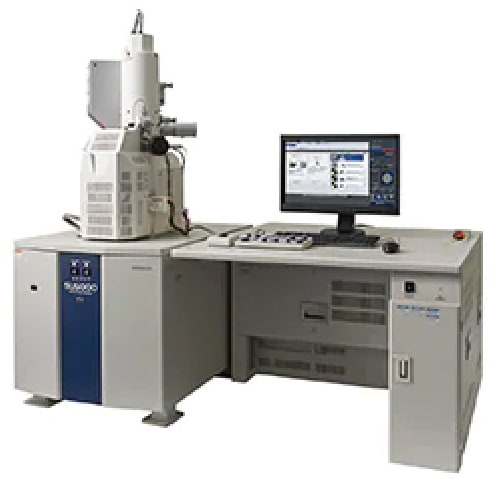
Schottky Field Emission Scanning Electron Microscope SU5000
![]()
2 As the number of specimens tested in hospitals and laboratories is increasing due to the aging of the population, there is a need to process more specimens in a limited amount of time. Our cobas e801 immunoanalyzer used for clinical testing, maintains the same width as the previous model, and within the allowable increase in depth, the test processing speed (throughput) per specimen has been increased to approximately 176% through mechanical system acceleration and optimization. Accordingly, power consumption per specimen during operation and standby has been improved to 75% compared to the previous model. Further, the optimized flow path length accompanying the higher speed reduce reagent consumption per test to two-thirds of that of conventional models, while also reducing the amount of chemicals used in reagents. In addition to contributing to the reduction of CO₂ emissions associated with electricity consumption, Hitachi High-Tech will contribute to the prompt provision of patient diagnostic results and other data by further accelerating testing speed, while also helping to reduce operator workload by improving the efficiency of testing operations.
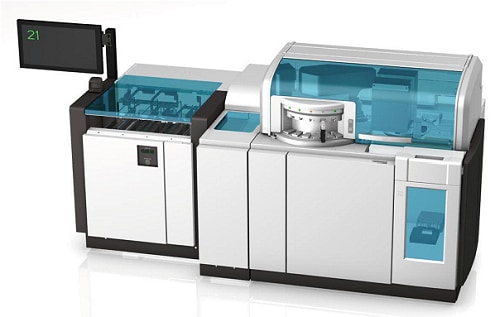
Immunoanalyzer cobas e801
5 Support procurement partners in reducing CO2 emissions from products and commercialization aimed at provision to customers
FY2022 Results
Visualizing CO2 emissions in the entire supply chain linked to the Group
The Hitachi High-Tech Group is working toward carbon neutrality in its Scope 1 and Scope 2 CO₂ emissions by switching to renewable energy sources and other initiatives, but the challenge is Scope 3, which accounts for the majority of Group emissions. Scope 3 emissions comprise CO₂ emitted up-stream (during the procurement of raw materials and parts) and down-stream (during actual use) in the supply chain. It is difficult for the Hitachi Group to directly reduce these emissions, and impossible to reduce them unless the entire supply chain is involved. The Group's goal is to achieve carbon neutrality throughout its value chain by FY2050, and reduce carbon emissions 50% by FY2030.
To achieve this goal, procurement partners who cooperate with the Group in various processes, such as the processing and assembling of parts for our products, must understand and cooperate with our efforts to reduce CO₂ emissions throughout the supply chain. To this end, it is essential to create systems and provide support enabling procurement partners to work toward CO₂ reductions to the extent possible without overburdening them. In FY2022, we selected environmentally advanced partner companies from among the Group’s many procurement partners, and jointly launched initiatives aimed at considering how we can work together to achieve CO2 reductions. For details, please refer to Materiality 4, Action Plan 3.
Initiatives for FY2024
Visualizing CO2 emissions per part and establishing an inflastructure facilitating reductions, incorporating GHG calculation tools in applications with the aim of providing them externally
In order to clearly state the amount of CO₂ emitted during manufacturing for each part produced by the Group going forward, we must ascertain the CO₂ emissions of purchased products.
Currently, the Group is making efforts to determine the greenhouse gas (GHG) emissions of all procurement partners involved in the manufacture of our products. In the future, we will launch efforts to ascertain the C O₂ emissions of overseas procurement partners with the aim of visualizing the CO₂ emissions associated with each part. Due to issues including the fact that CO₂ emission intensity differs in each country, a number of steps are required to accurately determine CO₂ emissions in Japan and overseas. We will systematize the calculation of CO₂ emissions in an effort to contribute to the realization of a decarbonized society.
-
Global regulations are intensifying as developed countries in Europe and the US raise their reduction targets for 2030 in order to achieve carbon neutrality by 2050. As customer demands for reductions are also on the rise, the visualization and reduction of CO₂ emissions in the supply chain have become a corporate issue for companies to continue business. For this reason, Hitachi High-Tech, and indeed all companies with global supply chains, must work towards these ends.
At present, we cannot respond sufficiently to climate change only through customer efforts to reduce CO₂ emissions. Efficient visualization and management of CO₂ emissions by customers and suppliers will lead to reductions in CO₂ emissions in customer supply chains. This will also enable customers to respond to CO₂ data requests from higher level customers, leading to continued business with up-stream customers.
The Group will first promote internal efforts to collect and compile CO₂ emissions data from procurement partners, systematize and incorporate it into applications, and in the future, provide it to customers, thereby contributing to the understanding and reduction of CO₂ emissions in external supply chains.
Action Targets 1 Realize a decarbonized society Action
Action Targets 2 Realize a recycling oriented society
6 Developing and providing solutions to increase corporate value for customers in the value chain, including lithium-ion battery reuse, recycling, and manufacturing, starting with commercial EV fleet management companies
FY2022 Results
Contributing to a sustainable global environment at every stage of the value chain
The need for automotive electrification is increasing as we move toward the realization of a decarbonized society. Accordingly, there is a growing need to promote the shift to EVs, extend the life of lithium-ion batteries (LiBs), and effectively utilize valuable metals and reduce the environmental impact of LiB production and recycling processes.
In FY2022, we conducted a proof-of-concept (PoC) and proof-of-value (PoV) using our remote degradation diagnostic service for automotive LiBs to understand the degradation conditions of EV LiB data at the cell level from a cumulative total of several tens of thousands of units in operation. We believe that this service will lead to an environment that maximizes the use of battery life and the reuse and recycling of retired batteries. In FY2022, we also developed an EV transition simulation application that shows the cost and CO₂ reductions that would result from the introduction of EV vehicles. This application is expected to be a tool to encourage EVs in regions and business sectors that have not yet made much progress in EV conversion. We will continue to contribute to the realization of carbon neutrality by developing services and tools that contribute to a sustainable global environment in all aspects of supply chain.
Initiatives for FY2024
Aiming to resolve customer issues throughout the value chain
In countries and regions where diesel trucks are used for agriculture and forestry, switching to hybrid vehicles can reduce CO₂ emissions associated with vehicle use. We will identify issues in each business that owns and operates such vehicles and make proposals to them.
At present, we are proposing this service to car leasing and fleet operators, but in the future, we will propose this service to domestic and overseas customers, while uncovering customer issues throughout the value chain and creating solutions.
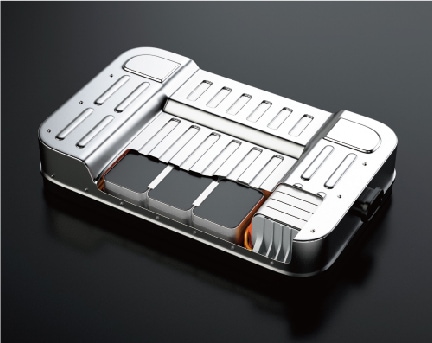
Lithium-ion battery
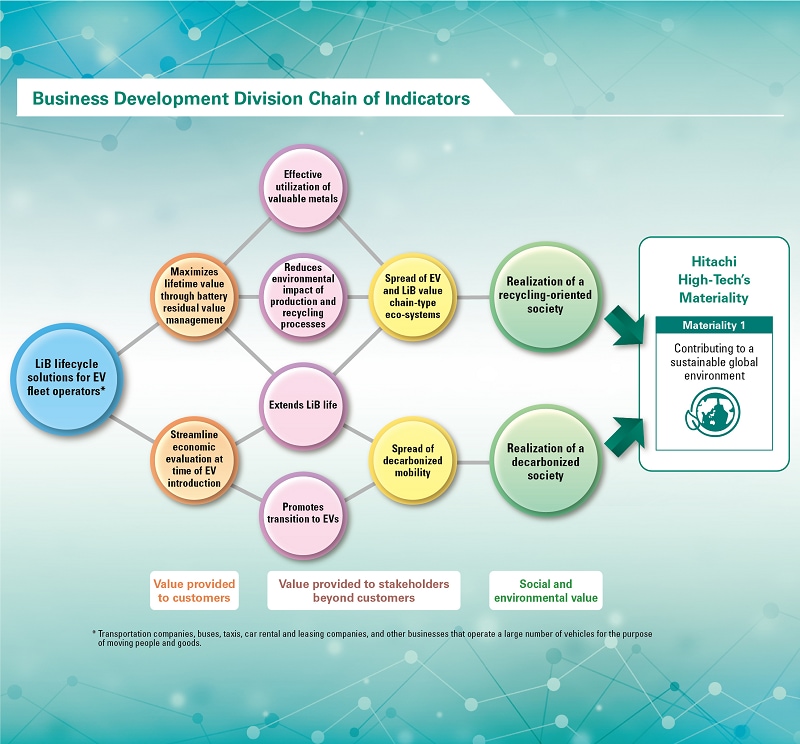
Action Targets 2 Realize a recycling oriented society
7 Developing and providing new manufacturing methods that enable the production of aluminum products using recycled materials![]()
FY2022 Results
Development of an aluminum hot stamping processing technology using 100% recycled aluminum materials that contributes to a significant reduction in CO2 emitted during the manufacture and use of aluminum ingots
While conventional aluminum sheet processing involves the use of bauxite to make new aluminum sheets, Hitachi High-Tech has established a technology for forming aluminum sheets from discarded aluminum, such as aluminum car wheel scrap. This reduces CO₂ emission by 97% compared to aluminum sheets formed using new ingots. Further, as recycled aluminum becomes easier to mold when heated, we also developed an aluminum hot stamping formation technology, which is a new method utilizing recycled aluminum sheets.
In 2022, Hitachi High-tech collaborated with a bicycle manufacturer to develop bicycle frames using recycled aluminum materials and aluminum hot stamping. In November that same year, this product was exhibited at the Saitama Cycle Festa, where it attracted a significant amount of attention. Manufacturing a bicycle frame usually generates 18.4 kg of CO₂, but using aluminum hot stamping technology, we were able to reduce CO₂ emissions to 0.62 kg.
In FY2022, we also used our aluminum hot stamping technology to develop everyday products, including chairs and snow shovels, which we are currently preparing for general sales. This technology has also attracted a lot of attention for its ability to reduce CO₂ emission even when manufacturing products in small lots, such as electric wheelchairs and industrial robots.
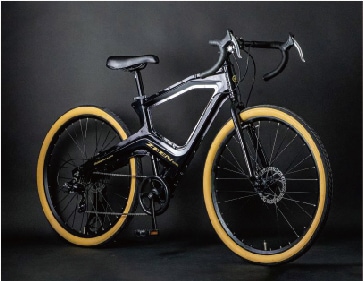
Bicycle with frame made using recycled aluminum
Initiatives for FY2024
Aiming to expand into automobiles and compact mobility
Once again in FY2023, we participate in the exhibit at the Saitama Cycle Festa, where we will announce and sell both mass-produced and final versions of 200 bicycles with frames made using recycled aluminum. We will also commence sales of chairs and snow shovels made using recycled aluminum to the general public in an effort to promote awareness of recycled aluminum as a material and products that use it.
The use of aluminum hot stamping technology also has the advantage of reducing product manufacturing workloads and lowering capital investment. In FY2023, we will promote these advantages and pursue technologies by applying hot stamping to products manufactured in small lots, such as robots and electric wheelchairs. In the future, we will take resolute steps toward the application and deployment of this technology in other fields, such as automobiles (including EVs) and compact mobility.
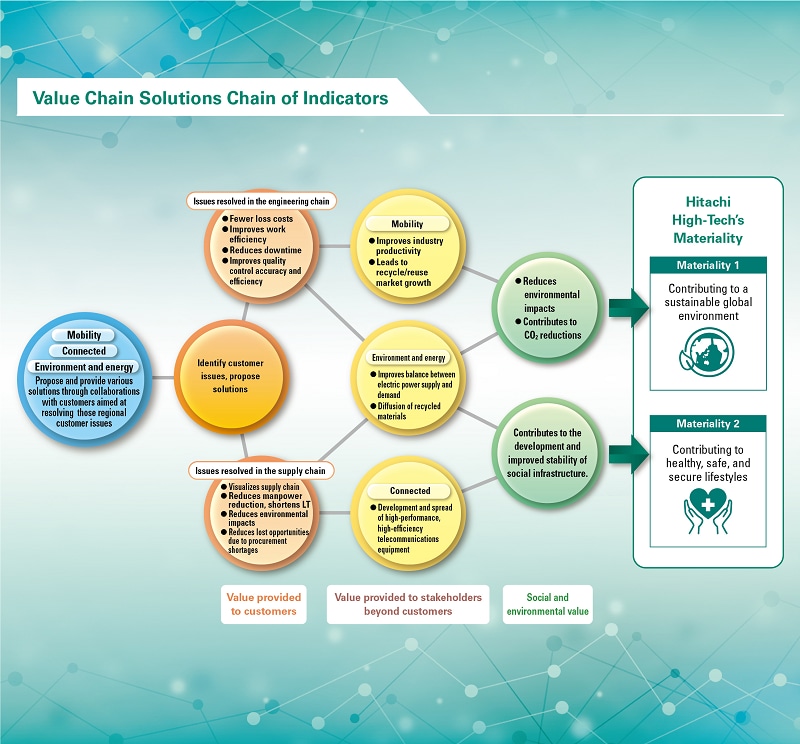
Topic
Provision of recycling test and inspection solutions![]()
Contribute to the development of circular economies within the metals industry by enabling scrap and waste metals to be recycled as high-quality feedstock for foundries, metal fabrication and metal processing facilities.
There is a global drive to recycle end-of-life products. This is important for metals as depleted natural resources is making them increasingly difficult to extract. Mining can have a negative environmental and human impact, including widespread release of greenhouse gases and potentially hazardous working conditions.
For over four decades we have been developing analytical equipment alongside the metals industry. Today we are equipping metals recycling businesses or customers with the analytical capability to test and sort the vast amount of material that pass through their facilities each day, making it possible to rapidly recycle metals to meet feedstock demands of foundries and other metal fabricators, thereby reducing reliance on new material.
However, the correct metal alloy specification must be used for a given application. Undetected tramp or trace elements can lead to failure in the field. Within the industry, incorrect materials have caused catastrophic failure of household appliances, buildings, and aircraft. This has made metals fabricators nervous of using scrap metal that may contain hidden impurities.
Our tools are used by large and small metal recycling businesses, globally. Within Europe and Thailand, they can be used to ensure recycled material from those facilities can enter the metals trading market, reducing waste, and working towards a circular economy for metals.
For example, a handheld X-ray Fluorescence (hereinafter, “XRF") analyzer is used on incoming scrap within steel mills for chemical composition to ensure it meets specification. This steel is then passed to foundries who will use either a handheld XRF or Optical Emission Spectrometer (hereinafter, “OES") to again verify the composition and check for tramp and trace elements. Moving to the next stage of the process, metal fabrication, OES, handheld XRF analyzer and Laser Induced Breakdown Spectroscopy are all used to verify the grade and composition of incoming materials and to avoid in-house mix-ups. An XRF analyzer is used at final inspection to determine chemical composition before shipping. Finally, once the product is recycled, an XRF analyzer is also used within scrapyards or recycling companies to sort the metal scrap by composition and feed it back to steel mills or foundries, thereby completing the metals circular economy.
The facilities boast high throughput and are frequently situated outdoors, necessitating weather-proofed instruments with rapid data transfer capabilities and extended battery life. These key features make the analyzers an essential tool, empowering metals manufacturing facilities to utilize scrap metal with utmost confidence.
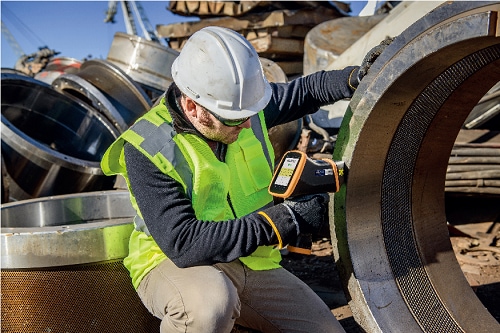
8 Initiatives aimed at improving resource and water use efficiency at Group companies in Japan
FY2022 Results
Reducing waste generation and water consumption on a per-unit basis, aiming for a recycling-oriented society with the goal of zero emissions in final waste disposal
Through reductions based on environmentally conscious product design, recycling facilitated by careful separation and collection, and the reuse of unused items in our product manufacturing processes, we aim to realize a recycling-oriented society by improving resource use efficiency by 50% or more compared to the base year by FY2050, with the goal of zero emissions (0.5% or less of waste emissions) in final disposal.
With regard to water resources, we are striving to improve water usage efficiency by reducing the amount of water used through productivity improvements and updates to water-saving equipment. In FY2022, there was no significant increase in water consumption due to the renewal of cooling water circulators and other equipment at manufacturing sites, leakage prevention measures, and refurbished water supply pumps and pipes. Every year, we conduct water stress assessments for the Hitachi High-Tech Group globally and water risk assessments for all of our sites in Japan. Although we do not have any business locations that are high in terms of stress or risks, we will continue periodic evaluations and make efforts to avoid risk at locations where risks can be reduced. With regard to resource recycling, we have been able to reduce cardboard and wood waste through the reuse of packaging and the use of returnable boxes for parts deliveries to suppliers and customers. We also promote resource recycling by expanding the range of products incorporating environmentally conscious design and sharing examples of reductions on the Company intranet. Further, to effectively utilize plastic waste generated during the manufacture of semiconductors, in FY2022, we devised a route for the collection of valuable materials by developing a waste acceptance company. Hazardous waste is managed centrally using Hitachi High-Tech Group proprietary data collection tools to manage the volume and export of each type of waste generated, ensuring compliance with relevant laws and regulations and proper disposal within the Group.
Initiatives for FY2024
Aiming to improve both water and resource use efficiency by 50% or more compared to the base year by FY2050.
In 2023, we plan to upgrade water supply facilities to ensure a stable supply of water, drainage facilities, and leakage prevention measures in order to strengthen production at our manufacturing sites. In 2024, we plan to replace leaking and aging drainage pipes and upgrade cooling water flow systems. We will share examples of water measures with all sites, including those overseas, through our intranet to improve the efficiency of water use throughout the Group. To effectively utilize plastic waste, we will continue developing new companies and creating new collection routes to recover plastic waste as a valuable resource. Specifically, we will examine emissions at sites where the waste plastic effective utilization rate is below 100%, survey disposal contractors, and formulate a plan to improve effective utilization rates. Implementation examples will be shared on our intranet to promote the effective utilization of these systems.
Action Targets 3 Realize a society in harmony with nature
9 Biodiversity conservation initiatives
FY2022 Results
Maintaining insect hotels and planting seedlings in their native areas to improve biodiversity, and in light of restrictions on activities due to the pandemic, employees are conducting biodiversity conservation activities at their homes
Economic development has been accompanied by the growing destruction and pollution of the natural environment and the overuse of resources, with Earth's biodiversity now facing a crisis. Hitachi High-Tech is engaged in Group-wide efforts to conserve and improve biodiversity to realize a rich future for both humans and nature. In May and November, the Takao Forest Nature School cleared bamboo grass and weeds, and removed dead trees and logs in the forest maintenance area managed by the Seven-Eleven Foundation, which serves as a base for activities in the suburbs of Tokyo that is easily accessible for employees located near our head office. Bamboo grass removed during forest maintenance work was effectively used to replace old nesting materials in the insect hotel previous installed by Hitachi High-Tech to provide a home for insects. During these activities, an orientation and lecture were held to introduce the nature school facilities and biodiversity to participating employees. Additionally, insect hotel was installed at Saitama site to observe the ecology of living organisms.
- An insect hotel was also installed at the Woodlands of Hitachi High-Tech Science, located on the premises of the Hitachi High-Tech Science Fuji Oyama Works. In recognition of ongoing efforts to conserve and restore biodiversity, this forest received the highest-ranked AAA rating from the Ecosystem Conservation Society-Japan (ECSJ) when renewing it certification under the Japan Habitat Evaluation and Certification Program (JHEP).
- At the Hitachi High-Tech Yasato Forest in Ishioka, Ibaraki Prefecture, where we continue to engage in forest conservation activities, a cypress grove was cleared to create a sunlit area where seedlings of deciduous broad-leaved trees selected from plant species native to the area were planted to convert part of the forest into an environment more hospitable to living things.
- As pandemic restrictions and other conditions forced us to limit the number of participants working in actual forests, in FY2022, we also held hybrid biodiversity conservation activities that employees conducted at their homes. This activity commenced in June with the production of bird calls (similar to a whistle, used outdoors to imitate bird sounds). The bird calls are made from oak trees harvested during forest maintenance work by the Takao Forest Nature School. Many employees signed up to make bird calls, which were popular with employees and their families, and in December, employees also made Christmas wreaths at home using natural materials collected by the Takao Forest Nature School. Going forward, we will continue to conduct hybrid biodiversity conservation activities that can be done at home, while also engaging in conservation activities that involve going out into actual forests.
Initiatives for FY2024
Preparing to acquire the Woodlands of Hitachi High-Tech Science OECM certification, and enhancing the mixed needle and broadleaf forest area in the Hitachi High-Tech Yasato Forest
As climate change is a global issue that demands an urgent response, we will continue to focus on biodiversity conservation activities, which are becoming equally important. Other places than National Parks that are protected, but have the potential for the effective and long-term conservation of biodiversity, are known as other effective area-based conservation measures (OECM), and we aim to acquire OECM certification for the Woodlands of Hitachi High-Tech Science. In FY2023, we will make preparations for certification in FY2024, while also aiming to enhance the mixed needle and broadleaf forest area in the Hitachi High-Tech Yasato Forest. We will maintain efforts to further enrich forests by reintroducing native plants to these areas on the basis of botanical surveys.
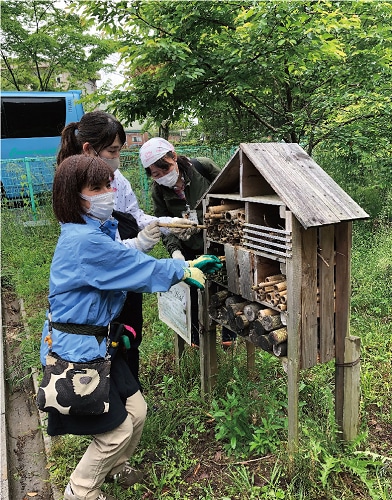
The Takao Forest Nature School replaces nesting materials in an insect hotel
